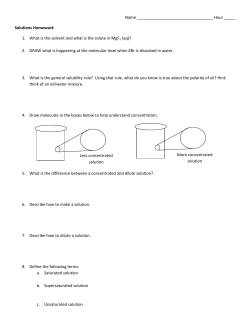
Document 154422
6.3 Counting by Weighing: Atoms by the Gram • With nails, we used a dozen as a convenient number in our conversions. • A dozen is too small to use with atoms. • We need a larger number because atoms are so small. • The chemist’s “dozen” is called the mole (mol). One mole of anything is 6.022 × 1023 units of that thing. This number is called Avogadro’s number, named after Amadeo Avogadro (1776–1856). One mole of marbles corresponds to 6.022 × 1023 marbles. One mole of sand grains corresponds to 6.022 × 1023 sand grains. Converting moles to number of atoms: Convert 3.5 mol helium to the number of helium atoms. Converting number of atoms to moles: Convert 1.1 x 1022 silver atoms to moles of silver. These pictures have the same number of atoms. The weight of one mole of atoms changes for different elements. Molar Mass and Atomic Mass • The atomic mass unit (amu) is defined as onetwelfth of the mass of a carbon-12 atom. • The molar mass of any element—the mass of 1 mol of atoms of that element—is equal to the atomic mass of that element expressed in atomic mass units. • One copper atom has an atomic mass of 63.55 amu. • 1 mol of copper atoms has a mass of 63.55 g. • The molar mass of copper is 63.55g/mol. The mass of 1 mol of atoms of an element is its molar mass. • The mass of 1 mol of atoms changes for different elements: • The lighter the atom, the less mass in one mole of that atom. Converting between Grams and Moles Calculate the number of moles of sulfur in 57.8 g of sulfur. Converting between Moles and Grams: Calculate the mass of aluminum (g) in 6.73 moles of aluminum. Converting between Grams and Number of Atoms: How many aluminum atoms are in an aluminum can with a mass of 16.2 g? Converting Between Grams and Moles of a Compound Requires the Molar Mass • The molar mass of a compound in grams per mole is numerically equal to the formula mass of the compound in atomic mass units. • The formula mass for a compound is the sum of the atomic masses of all of the atoms in a chemical formula. The formula mass of CO2 is found: The molar mass of CO2 is: Converting Between Grams and Moles of a Compound: Calculate the mass in grams of 1.75 mol of water. Converting Between Grams and Moles of a Compound: Calculate the mass in grams of 1.75 mol of water. Converting Between Number of Molecules and Mass of a Compound: What is the mass of 4.78 x 1024 NO2 molecules? Converting Between Number of Molecules and Mass of a Compound: What is the mass of 4.78 x 1024 NO2 molecules? 6.5 Chemical Formulas as Conversion Factors • The formula for carbon dioxide, CO2, means there are two O atoms per CO2 molecule. • We write this as: 2 O atoms : 1 CO2 molecule • Similarly, 2 dozen O atoms : 1 dozen CO2 molecules • And: 2 mol O: 1 mol CO2 Converting Between Moles of a Compound and Moles of a Constituent Element: Find the number of moles of O in 1.7 mol CaCO3. Converting Between Grams of a Compound and Grams of a Constituent Element: Find the mass of sodium in 15 g of NaCl. • GIVEN: 15 g NaCl • FIND: g Na • SOLUTION MAP: • SOLUTION: FIGURE 6.2 Mole relationships from a chemical formula • The relationships inherent in a chemical formula allow us to convert between moles of the compound and moles of a constituent element (and vice versa). 6.6 Mass Percent Composition of Compounds • The mass percent composition, or mass percent, of an element is the element’s percentage of the total mass of the compound. Finding Mass Percent Composition • A 0.358-g sample of chromium reacts with oxygen to form 0.523 g of the metal oxide. • The mass percent of chromium is: Using Mass Percent Composition as a Conversion Factor • We can use mass percent composition as a conversion factor between grams of a constituent element and grams of the compound. • The mass percent composition of sodium in sodium chloride is 39%. This can be written as: Using Mass Percent Composition as a Conversion Factor • The mass percent composition of sodium in sodium chloride is 39%. • This can be written in fractional form: These fractions are conversion factors between g Na and g NaCl. The FDA recommends that adults consume less than 2.4 g of sodium per day. How many grams of sodium chloride can you consume and still be within the FDA guidelines? Sodium chloride is 39% sodium by mass. 6.7 Mass Percent Composition from a Chemical Formula • Based on the chemical formula, the mass percent of element X in a compound is: Mass Percent Composition from a Chemical Formula: Calculate the mass percent of Cl in C2Cl4F2, freon-114. 6.8 Calculating Empirical Formulas for Compounds • Can we calculate a chemical formula from mass percent composition? • Yes, but it is the empirical formula, not the molecular formula. • An empirical formula only gives the smallest wholenumber ratio of each type of atom in a compound, not the specific number of each type of atom in a molecule. • The molecular formula is always a whole-number multiple of the empirical formula. • For example, the molecular formula for hydrogen peroxide is H2O2 and its empirical formula is HO. Calculating an Empirical Formula from Experimental Data: Decomposition of Water to 3.0 g H and 24 g O. • Write a pseudo-formula for water: • To get whole-number subscripts in our formula, divide all the subscripts by the smallest one, in this case, 1.5. • Our empirical formula for water, which in this case also happens to be the molecular formula, is H2O. Obtaining an Empirical Formula from Experimental Data 1. 2. 3. 4. 5. Write down (or calculate) as given the masses of each element present in a sample of the compound. If you are given mass percent composition, assume a 100-g sample and calculate the masses of each element from the given percentages. Convert each of the masses in Step 1 to moles by using the appropriate molar mass for each element as a conversion factor. Write down a pseudo-formula for the compound, using the moles of each element (from Step 2) as subscripts. Divide all the subscripts in the formula by the smallest subscript. If the subscripts are not whole numbers, multiply all the subscripts by a small whole number (see the following table) to arrive at wholenumber subscripts. Calculating an Empirical Formula from Reaction Data A 3.24-g sample of titanium reacts with oxygen to form 5.40 g of the metal oxide. What is the empirical formula of the metal oxide? GIVEN: FIND: 3.24 g Ti 5.40 g metal oxide empirical formula You cannot convert mass of metal oxide into moles because you would need its formula, and that is what you are trying to find. You are given the mass of the initial Ti sample and the mass of its oxide after the sample reacts with oxygen. The difference is the mass of oxygen that combined with the titanium. Calculating an Empirical Formula from Reaction Data • To find the mass of oxygen, subtract the mass of titanium from the mass of the “metal oxide.” The difference is the mass of oxygen. Mass Ti Mass O = 3.24 g Ti = Mass oxide – Mass titanium = 5.40 g Ti & O – 3.24 g Ti = 2.16 g O • Now you can convert the mass of each element to moles.
© Copyright 2025





















